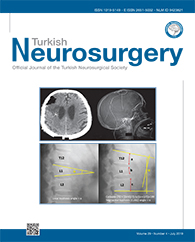2Kafkas University, School of Medicine, Department of Orthopaedics and Traumatology, Kars, Turkey
3Antalya Training and Research Hospital, Department of Orthopaedics and Traumatology, Antalya, Turkey
4Esnaf Hospital, Orthopaedics and Traumatology Clinic, Mugla, Turkey
5Ordu University, School of Medicine, Department of Orthopaedics and Traumatology, Ordu, Turkey DOI : 10.5137/1019-5149.JTN.25025-18.3 AIM: To compare the clinical and functional outcomes between combined anterior and posterior 2-segment spinal fusion and posterior 3-segment spinal fusion in patients with thoracolumbar (TL) burst fractures at risk for posttraumatic kyphosis without neurological deficit.
MATERIAL and METHODS:Twenty-seven patients with TL burst fracture, >20° kyphosis and/or 50% collapse, and posterior ligament injury, but without neurological deficit, were randomly assigned into posterior and combined groups. Posterior treatment was 3-segment (1 level below, fractured level and 2 levels above) posterior spinal fusion. Combined treatment was including 1 cranial and 1 caudal levels posterior spinal fusion, followed by anterior corpectomy, cage, and bone grafting. Patients were followed-up for a mean duration of 117.7 ± 8.7 months (range, 98-132 months). At the final follow-up, the clinical and functional means of the groups were compared using degree of kyphosis, visual analogue scale (VAS), and Roland-Morris and Oswestry scores.
RESULTS: Mean patient age was 38.5 ± 2.4 years (range: 18-68 years). Fourteen and 13 patients were treated with the combined and posterior approach, respectively. Age (40.0 ± 10.3 and 37.0 ± 14.2 years; p=0.519), sex (female/male, 3:10 and 5:9; p=0.385), mechanism of injury (p=0.513), fractured levels (p=0.185), type of fracture (p=0.293), degree of kyphosis at initial admission (p=0.616), collapse (p=0.155), canal narrowing (p=0.280), follow-up (p=0.076) and accompanied limb fracture (p=0.374) were similar between groups. Duration of hospital stay was similar between two groups (p=0.102). However, blood loss was higher in combined group (195 ml versus 358ml, p=0.003). A 14.2° correction was achieved in the posterior group and 16.9° in the combined group (p=0.61). Loss of correction at the last follow-up visit was 2.1° with a final kyphosis of 7.2° in the posterior group, and 1.2° with a final kyphosis of 5.5° in the combined group. The differences in the correction of kyphosis (p=0.616), postop kyphosis (p=0.756), loss of correction (p=0.141) and final kyphosis (p=0.085) between the treatment groups were not significant. At the last follow-up visit of the posterior and combined groups, the VAS (16.4 ± 14.8 vs. 17.6 ± 16.6; p=0.685), Roland-Morris (27.2 ± 27.3 vs. 29.6 ± 20.5; p=0.519), and Oswestry scores (15.0 ± 13.1 vs. 17.7 ± 11.5; p=0.302) were similar.
CONCLUSION: Both treatment methods are similar in terms of clinical and functional outcomes.
Keywords : Thoracolumbar burst fracture, Anterior, Posterior, Fusion, Randomized clinical trial




